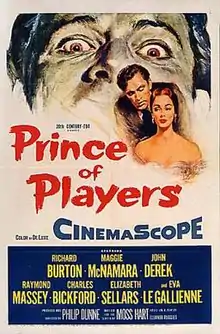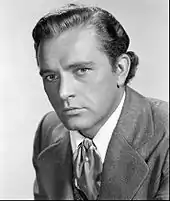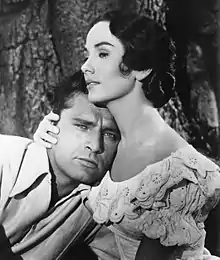| Prince of Players | |
|---|---|
 Original film poster | |
| Directed by | Philip Dunne |
| Written by | Moss Hart |
| Based on | Prince of Players 1953 book by Eleanor Ruggles |
| Produced by | Philip Dunne |
| Starring | Richard Burton Maggie McNamara John Derek Raymond Massey Charles Bickford Elizabeth Sellars Eva Le Gallienne |
| Cinematography | Charles G. Clarke |
| Edited by | Dorothy Spencer |
| Music by | Bernard Herrmann |
Production company | 20th Century Fox |
| Distributed by | 20th Century Fox |
Release date |
|
Running time | 102 min |
| Country | United States |
| Language | English |
| Budget | $1,570,000[1][2] |
| Box office | $650,000 domestic rentals[2] |
Prince of Players is a 1955 20th Century Fox biographical film about the 19th century American actor Edwin Booth. The film was directed and produced by Philip Dunne from a screenplay by Moss Hart, based on the book by Eleanor Ruggles. The music score was by Bernard Herrmann and the cinematography by Charles G. Clarke. The film was made in CinemaScope and in DeLuxe Color.
The cast featured Richard Burton, Maggie McNamara and John Derek, along with Raymond Massey, Charles Bickford, Elizabeth Sellars and Eva Le Gallienne.
Plot

Edwin "Ned" Booth is the son of the noted thespian Junius Brutus Booth and the older brother of another actor, John Wilkes Booth. Beginning In 1848, as a boy, and into early manhood, he travels with and assists Junius, who is often drunk and seems at times on the brink of madness.
Several years go by. A theater owner, Dave Prescott, eagerly anticipates a Junius performance in San Francisco, but the actor is again unable to perform and decides to leave the theatrical run. Junius hands over his crown – a literal theatrical crown worn during his rendition of Richard III, to Ned, who has memorized his father's lines. Ned's first performance is of Richard III during a show at a mining camp, where the miners, disappointed at first, are ultimately pleased by what they see. Prescott, however, breaks the news shortly after that Junius has died.
Ned returns east, where John Wilkes Booth is starring in The Taming of the Shrew to great acclaim at Ford's Theatre in Washington, D.C. Billed as the son and successor to Junius Brutus Booth, John is planning a tour and asks Ned if he will be his manager along with their younger sister, Asia. Somewhat contemptuous of his upstart brother's early success as an actor, Ned declines. He tells his younger brother that he hasn't learned the craft the way he, Ned, has by traveling with, hearing the performances, and looking after their father for many years. Ned begins a theater tour of his own with Dave Prescott. He travels to New Orleans, where he meets, then soon marries, Mary Devlin, a member of a theatrical company who plays Juliet opposite Ned's role as Romeo.
The Civil War breaks out and John is said to be working steadfastly for the Confederacy's cause. He declines an offer from Ned to go to London together for a production of Hamlet, and when a pregnant Mary falls ill, Ned begins drinking heavily and missing performances.
Mary's death turns her husband morose. Then comes the terrible news one night that John Wilkes Booth has assassinated President Abraham Lincoln by gunshot at Ford's theater.
Weeks after the assassination, and his brother's subsequent death on a farm in Virginia, Ned has decided to return to the stage in Hamlet. On opening night the theater is packed by a mob incensed by the murder of the president and blaming not only Booth but all actors and theaters in general. One protester says the president "died in the very doorway to hell" because he was murdered in a theater.
Backstage, Dave Prescott tells Ned that the show must be canceled. Ned insists that he wants to go on for his profession as well as his family name, remembering that his late wife once said that acting was his gift, his purpose in life and he must "never be derelict" to that purpose.
Ned is seated center stage on the throne as the curtain comes up. The mob hurls insults, vegetables, and other objects at Ned as the other actors rush off the stage. Ned remains seated, immobile, and absorbs the abuse until the crowd's fury exhausts itself. Finally one of the protesters declares "he's got guts", shouts "Booth, you're alright!", and begins clapping.
Gradually more of the mob join him, the other actors return to the stage, and the film ends with Ned hearing his late wife speaking part of Juliet's soliloquy as the crowd's approval continues to rise.
Cast

- Richard Burton as Edwin "Ned" Booth
- Maggie McNamara as Mary Devlin
- John Derek as John Wilkes Booth
- Raymond Massey as Junius Brutus Booth
- Charles Bickford as Dave Prescott
- Elizabeth Sellars as Asia Booth
- Christopher Cook as Edwin Booth at age 10
- Dayton Lummis as English physician
- Ian Keith as Ghost of Hamlet's Father in Hamlet
- Paul Stader as Laertes in Hamlet
- Louis Alexander as John Booth at age 12
- William Walker as Old Ben
- Charles Cane as Theater Assistant
- Mae Marsh as Witch in Macbeth
- Stanley Hall as Abraham Lincoln
- Sarah Padden as Mary Todd Lincoln
- Ruth Clifford as English Nurse
- Ivan Hayes as Bernardo in Hamlet
- Paul Frees as Francisco in Hamlet
- Ben Wright as Horatio in Hamlet
- Melinda Markey as Young Lady
- Eleanor Audley as Mrs. Montchesington
- Percival Vivian as Polonius in Hamlet
- George Melford as Stage Doorman
- Ruth Warren as Nurse
- Richard H. Cutting as Doctor
- Lane Chandler as Colonel
- Steven Darrell as Maj. Rathbone
- Tom Fadden as Trenchard
- Henry Kulky as Bartender
- Olan Soule as Catesby in Richard III
- Eva Le Gallienne as Queen Gertrude in Hamlet
- Jack Raine as Theater Manager
- Paul Wexler as Miner
- Ethan Laidlaw as Barfly
- Jack Mower as Man in Audience
Production
Original book
The film was based on a book by Eleanor Ruggles, published in February 1953. She started researching it in 1948.[3]
The New York Times called it "an able biography."[4] Another review in the same paper called it "enthralling".[5] The book became a best seller.[6]
Development
20th Century Fox bought the film rights in January 1953, before the book had been published. Richard Burton, who had a contract with the studio, was linked with the project from the beginning, although there were reports he might play John Wilkes Booth. Darryl F. Zanuck, head of Fox, reportedly wanted Laurence Olivier or Marlon Brando for Edwin Booth. Sol Siegel was the original producer.[7][8]
In May 1953 Moss Hart signed to write the script.[9]
In April 1953, Fox announced the film would be shot in CinemaScope.[10]
Eventually Siegel dropped out as producer and was replaced by Philip Dunne. "Moss has done a really brilliant dramatisation of the book", said Dunne.[11]
In November 1953, Richard Burton signed a new seven-film contract with Fox, the first of which was to be the lead in Prince of Players.[12]
In June 1954, Jay Robinson was cast as John Wilkes Booth.[13]
In July 1954, Eva Le Galliene was hired as technical consultant (listed on the credits as "Special Consultant on Shakespearean Scenes") on the recommendation of Moss Hart[14] She later agreed to appear in the film as an actor, performing in scenes with Burton. It was her first film.[15][16] Dunne later said, "I couldn't find a director whom I thought could do justice to the script so Zanuck said 'direct it yourself'."[17] In July Dunne was appointed director as well as producer.[18]
Jay Robinson lost his part to John Derek.[19]
Shooting
Filming started August 1954.[20]
"On the first day, I was terrified", said Dunne. "There looking at me were Richard Burton, Raymond Massey, Eva Le Gallienne and up walks Charlie Bickford, old, cantankerous, and known to punch out directors before breakfast.' Anyone here you want me to kick real hard?' old Charlie asked."[21]
Dunne said directing was "fun when you have a good story and players who know what they're supposed to do."[22]
Dunne later said Hart's script was about half an hour too long and that Dunne trimmed it by cutting within scenes.[23]
Reception
The film was a financial failure, the first movie in CinemaScope to lose money. Dunne said he thought "it was too larded with Shakespeare".[24]
See also
References
- ↑ Solomon, Aubrey. Twentieth Century Fox: A Corporate and Financial History (The Scarecrow Filmmakers Series). Lanham, Maryland: Scarecrow Press, 1989. ISBN 978-0-8108-4244-1. p249
- 1 2 "20th Blessing". Variety. 9 November 1955. p. 20.
- ↑ Nichols, Lewis (March 8, 1953). "Talk With Eleanor Ruggles". The New York Times. p. BR14.
- ↑ Prescott, Orville (February 25, 1953). "Books of The Times". The New York Times. p. 25.
- ↑ Otis Skinner, Cornelia (March 1, 1953). "A Victim of Outrageous Fortune: The Life of Edwin Booth Is a Dramatic Story of Deep Sorrow and Great Triumph – Prince of Players: Edwin Booth. By Eleanor Ruggles. Illustrated. 401 pp. New York: W.W. Norton & Co. $4.50. Outrageous Fortune". The New York Times. p. BR1.
- ↑ "Toop Best Sellers: In Los Angeles – Fiction Leaders". Los Angeles Times. April 5, 1953. p. D6.
- ↑ Hopper, Hedda (January 28, 1953). "Edwin Booth's Life Story to Be Filmed". Los Angeles Times. p. B6.
- ↑ Pryor, Thomas M. (January 28, 1953). "Movie Writers Set New Pay Minimums: Seek Scale From $150 Weekly to $400 – Formula for TV Compensation Is Proposed". The New York Times. p. 24.
- ↑ Pryor, Thomas M. (May 9, 1953). "Lead in Western to Joan Crawford: Actress Signs With Republic in Profit Participation Deal to Play in 'Johnny Guitar'". The New York Times. p. 13.
- ↑ "Studio Plans 20 Cinemascope Films: 20th Century-Fox Announces It Will Release Spectacles in Fall and Continuing in 1954". Los Angeles Times. April 2, 1953. p. A1.
- ↑ Thompson, Howard (July 18, 1954). "Of Pictures and People: Blueprint for 'Prince of Players' -- A Chinese 'G. W. T. W.' -- Other Items". The New York Times. p. X5.
- ↑ Pryor, Thomas M. (November 24, 1953). "Fox Signing Starts for Cinemascope: Gregory Peck, Richard Burton and Kirk Douglas Hired -- Spencer Tracy Borrowed". The New York Times. p. 34.
- ↑ Schallert, Edwin (June 7, 1954). "Selznick Shaping 'War and Peace'; Jay Robinson to Enact Wilkes Booth". Los Angeles Times. p. B9.
- ↑ "Guy Madison Set for Modern Role: Actor, Long Associated With Old West, to Be Student in 'Five Against the House'". The New York Times. July 24, 1954. p. 7.
- ↑ Schallert, Edwin (August 28, 1954). "'Look to Mountain' Stars Teresa Wright; Queenly Roles Win Le Gallienne". Los Angeles Times. p. 13.
- ↑ Scheuer, Philip K. (September 26, 1954). "Filmland Says Le Gallienne Is 'A Living, Breathing Doll': 40 Years on Stage, She's Now in Films". Los Angeles Times. p. D4.
- ↑ Thomas, Kevin (June 8, 1966). "Screenwriter---an Unsung Hero With Plenty of Ideas". Los Angeles Times. p. D11.
- ↑ "Kidd Will Repeat Dances for Movie: Choreographer of Broadway 'Guys and Dolls' Gets Task for Goldwyn's Version". The New York Times. July 29, 1954. p. 18.
- ↑ Brownell, Jr., William H. (August 8, 1954). "Hollywood Round-Up: New Bullfight Venture – Andrews at Bat". The New York Times. p. X5.
- ↑ Schallert, Edwin (August 17, 1954). "Bickford Aids Booth in 'Prince;' Robinson Taking Broadway Leave". Los Angeles Times. p. B7.
- ↑ Jim Bawden (January 27, 1990). "Philip Dunne looks back at movies' golden age". Toronto Star (SA2 ed.). p. G8.
- ↑ Pryor, Thomas M. (September 19, 1954). "Hollywood Scene: Censure of Peck Stirs Film Council – Directors Hit Stride – Addenda". The New York Times. p. X5.
- ↑ Lee Server, Screenwriter: Words Become Pictures, 1987 p 109
- ↑ Schumach, Murray (April 3, 1962). "Directors Chided for Film Writing: Philip Dunne Urges That Scenarists Be on Sets Best-Known Scripts Used One Line". The New York Times. p. 43.